#Hostellerie Le Maréchal
Text
Wednesday, 18th September/Thursday, 19th September 2019 – Restaurant a l’Echevin, Colmar
As part of the deal at the Hostellerie Le Maréchal we had two night’s dinners included (not three, no matter what the young man on reception when we checked in insisted) and although you never know what you might get when it comes to hotel restaurants, in what is clearly paradise for gourmets, Alsace and the restaurant A l’Échevin did not let us down. The first night we drank a glass of local crémant in the bar first, alongside a snack of some rather wonderful pastry straws that were as light as you could wish, which suggested that at least their pastry chef was up to speed.

We then moved into the restaurant and were pleased to be shown to our table (Table 2 apparently) in the long, narrow dining room that overlooked the waters of La Lauch and the barques moored outside. We were slightly less pleased with the acoustics that meant we could hear every word issuing from the irritating couple on the table behind ours (Table 1) but that’s not the hotel’s fault! We were on a set menu with matching wines as part of the deal that the hotel had offered so the decision making process had been largely taken away from us. Now to see if the rest of the brigade could cook as well as the pastry chef. An amuse-bouche of a foie gras paté and an apricot sorbet suggested the answer to that question might well prove to be “yes”.
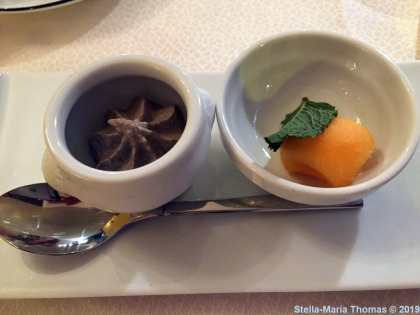
The menu itself started with what was listed as “Presskopf” of smoked haddock and smoked trout, basically the chef’s take on a regional speciality, brawn, but with fish and not the more usual meat. It was light, delicate, the jelly perfectly set and the herbs just providing a lift of flavour to counteract the oily fish. There were tiny chunks of vegetable alongside the chunks of trout and haddock and it not only looked lovely, it was lovely.
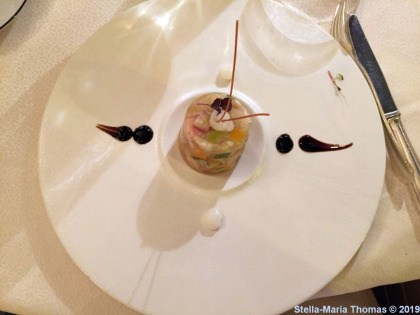
Fillet of pike-perch cooked in Riesling, with mangetout turned out to be a perfectly executed piece of fish, the skin crisp and golden, sitting on top of a bed of mangetout, with a puddle of creamy Riesling inflected sauce. Throw in the odd micro-herb and enjoy! It was also a perfect excuse to rip off a piece of the brilliant bread roll and dunk it in the leftover sauce afterwards. The kitchen was having none of that back!
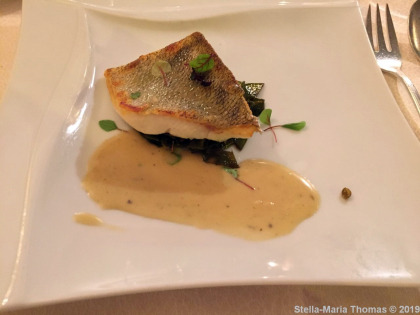
With both the fish dishes we drank a 2018 Alsace Pinot Blanc from Pierre Henri Ginglinger. The wine comes from a blend of Pinot Auxerrois from different parcels, harvested by hand and fermented over several months before being aged on fine lees. It’s a bright yellow in color, with white-fleshed fruit aromas, and peach notes. We liked it enough to make a note of it and to consider whether we needed to visit the Ginglinger domaine. While we pondered that question, the meat course arrived, a serving of leg of deer with cranberries, cross-border pasta specialty spaetzlés (as the French appear to spell it) and fromage blanc. The meat was cooked to perfection, as were the vegetables and to add a fillip to what might have seemed quite a restrained plate, there was also a “pastilla” full of slow cooked meat to enjoy alongside the pink cooked flesh that we’d been expecting. It was all beautifully executed and we knew we’d made a good choice to eat in the hotel.

A serving of perfectly kept Munster cheese from a local farm came next and was just the thing to help us finish off the red wine, a 2017 Alsace Pinot Noir “Les Princes Abbés” from Domaines Schlumberger, one of the big wine names in these parts. The wine itself is made of a blend of Pinot Noir (80% from the limestone Bollenberg plot and 20% from the marl-limestone Saering plot). Vinification occurs during a maceration period of two weeks and it is then matured in traditional tuns for 10 months. What you get is a wine that is cherry red with purple reflections, and an aroma of red fruit scents (blackcurrant, cherry) and a hint of rose. Redcurrant, blackberry, vineyard peach as it opens out and slight woodiness also come through. It was served at what we might consider a low temperature for red but to get the most out of these wines 16°C is what you’re looking for. It was smooth against the punchiness of the cheese and the combination was really rather wonderful. The spoonful of cumin seeds served alongside the cheese were an interesting – and welcome – touch too.

We finished off with a gourmandise du pâtissier which took the form of a gloriously gooey plum and raspberry confection, on a biscuit base that couldn’t be faulted, the ice cream all creamy and rich and the sorbet sharp and cleansing on the palate. It was looking good for our second night, and we went to bed happy after finishing our dessert wine (and cheering when the annoying pair behind us had cleared the room and gone to their own beds). It made the wine taste even better, which, as it was a 2017 Gewürztraminer Tradition – Gold Medal wine from Bott Frères was quite a smart trick. The wine is brilliant and crystal-clear in shades of light green and has a youthful, fresh and flowery (rose and acacia) aroma, added to an exotic taste of pineapple and oriental spices characteristic of Gewürztraminer. Perfect with dessert and on its own, as we went on to prove!
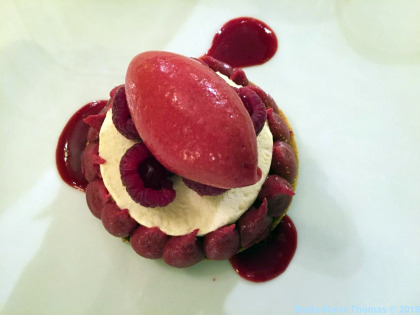
On the second night we wandered out for an aperitif, ending up drinking a glass of wine by the waterside at La Krutenau, for the simple reason that it was the first bar we came across that had waterside views and an empty table. It was another lovely evening so we were quite content to be outside a while longer.

On our return we decided it was getting a little too cold to stay out for a second aperitif so we took to the room just off the hotel’s courtyard for a second glass of wine and some more of their fabulous pastry straws, before swinging indoors to see what was on offer on the tasting menu. As ever they started us of with a delicate little amuse-bouche before things got serious. We’d deliberately avoided anything after the charcuterie plate at Joseph Cattin’s for the remainder of the day because we reckoned we’d be best arriving hungry. We didn’t even do the flammkuechen as aperitif nibbles thing because that seemed unwise. This time they started us with a cheesy mousse and a tiny tomato gazpacho, which was refreshing and sharp.
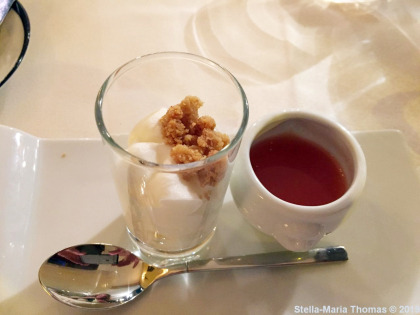
And then it was into the serious wine and food. The starter was a terrine of duck foie gras with figs and a fruit chutney. It was smooth and rich and fabulous and it probably didn’t need the toasted brioche with it (though I have to say we both caved and ate part of it). Given we also had more of their fantastic bread as well it was overkill, but gloriously so. With it we moved from the crémant to a far more suitable wine, a 2017 Pinot Gris from Maison Martin Jund, who are now entirely biodynamic in their practices. This wine is described as “expressive and tender, from the very beginning, a fruity wine if there is one”. The resulting wine is a golden yellow with metallic reflections, and the aroma is of ripe yellow fruits (pear, peach). It’s perfectly sweet and an ideal match for foie gras.

The second course was a crayfish casserole, tiny and packed with pieces of sweet-fleshed, juicy, tender crayfish tails, dotted with chives and swimming in a creamy sauce. I loved it (and the little Staub cocottes it was served in, which are from a brand that started in Alsace, and that cost an absolute fortune). I pondered the possibility of getting out of there with one hidden in my handbag! the sheer weight of it put me off the idea, if Lynne had not also vetoed it. We already had a fabric heart that was in our room as a present from the hotel when we arrived. That would be far easier to carry… I settled for mopping up the sauce with the bread roll and we sat and waited to see what else we would be fed.
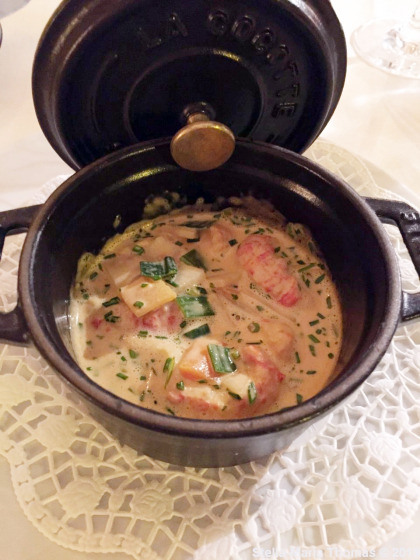
The second fish dish was a piece of nicely filleted halibut, in a saffron sauce. Saffron is tricky stuff – overdo it and you have a sauce that is bitter and deeply unpleasant. Get it right and you have something golden and warm. They got it right and the fish was also perfect, white and flaking and moist, sitting on a small pile of fresh carrots and a pool of pale golden sauce. Both this and the crayfish came with a 2016 Grand Cru Froehn Riesling from Jean Becker. This wine is made from grapes grown on limestone and sandstone at 270 to 300m on soil consisting of dark gray schistose marls, with fine white limestone beds as well as carbonate and ferruginous nodules. The wine resulting wine is floral and fruity, combining richness, finesse and breadth regardless of varietal and there is a fine and strong acidity that becomes salinity and minerality with aging. Am excellent choice once again. Someone really knows their wine and food matches, and they want you to have the best Alsace can offer

The interlude was a palate cleansing lime and apple sorbet which really woke the tastebuds up and prepared us for a meaty main course and a change of wine.

This came in the shape of a pink-cooked beef fillet, with a fine selection of small organic vegetables including a smooth as silk potato puree, some pickled radish and onions (tiny, sweet, giving a lift to the meat), courgettes, carrots, fine beans and broccoli. The meat could probably have been cut with a spoon, it was so tender and perfectly cooked. There is a sure hand at work in the kitchen, in the shape of the head chef, Thierry Chefdeville, who has been here for two decades, producing a very harmonious menu where each dish could stand along but equally fits together. I would happily eat there again, and that was before we made it all the way through the menu.

The wine served with the beef was a 2017 Alsace Pinot Noir from Pierre Henri Ginglinger. This is made from a blend of Pinot Noir from different plots, harvested by hand, then de-stemmed and allowed to macerate for 15 days. It is then moved to old wooden casks for malolactic fermentation. What you get as a result has a beautiful purple hue, and a nose that is very fruity with notes of cassis and cherries. It’s light, fresh and pleasant with a little tannin and is best served chilled down to between 12 and 14ºC. It also went very well with the assortment of three cheeses which included a relatively young Comté which always makes me happy. But then, Comté always makes me happy, a fact that can probably be confirmed by the bloke at Borough Market who sells it to me and to le Manoir Aux Quat’Saisons!

Pré-dessert was chocolate in a number of forms, including ice cream, and would have been a dessert in its own right (and certainly more than sufficient), especially with meringue as well, and I could have happily stopped there.

I was glad I didn’t stop there though. The pineapple and lemon cappuccino mojito-style might not have been desperately photogenic but it was desperately good, with a hit of alcohol and sharp pineapple, underneath a light, foaming lemon cream.

We ended the night full of food and nursing the dreaded food baby (twins I think), more than satisfied with our two dinners in a fine restaurant. We did get stuck with a second table full of irritating fellow diners again though, who were first minded to be annoyed by the service, which they felt was too slow (OK, it’s not quick but you’re there for an evening out so I’d prefer not to be rushed), and who then talked utter nonsense all night, strong in so many incorrect opinions (the Italians didn’t have any colonies or any colonial “adventures” – tell that to the Libyans, Ethiopians, Eritreans, and Somalians – and the Germans don’t make cheese being just two of them). So if you do go try and get Table 1 so there won’t be anyone behind you!
Travel/Food 2019 – Alsace and Baden, Days 6 and 7, Restaurant a l’Echevin, Colmar Wednesday, 18th September/Thursday, 19th September 2019 - Restaurant a l’Echevin, Colmar As part of the deal at the…
#2019#A l’Echevin#Aperitifs#Bars#Colmar#Cooking#Dinners#Drink#Drinks#Europe#Food#Food and Drink#France#Hospitality#Hostellerie Le Maréchal#Hotels#Restaurants#Travel#Wine
10 notes
·
View notes
Text
[author] [author_image timthumb=”on”]http://www.gourmetsandco.com/wp-content/uploads/2011/03/patrick2.jpg[/author_image] [author_info]
Le Clos du Cèdre
Beaune (Côte d’Or)
par Patrick Faus
[/author_info] [/author]
[learn_more caption=’ ‘] : cuisine sans intérêt
: cuisine correcte
: cuisine intéressante
: cuisine enthousiasmante
: cuisine exceptionnelle[/learn_more]
Une bien belle maison où, enfin, la cuisine est à la hauteur du décor.
Au calme, sous les grands arbres, les tables agréablement dressées autour du fameux cèdre dans le jardin de l’hôtel, le gravier qui crisse sous les pas des serveurs, une légère brise qui ne parvient même pas à refroidir les plats mais permet de respirer un peu… Nous ne sommes pas loin du lieu idyllique.
Une grande maison de maitre du siècle dernier abrite les chambres de l’hôtel, sans doute le plus beau de la ville. Un charme certain se dégage de l’ensemble et il fait bon s’attabler soit dans le jardin soit dans la superbe salle à manger au goût exquis tant dans la décoration que dans le choix de la vaisselle. Le charme et le chic de la bâtisse, que l’on retrouve dans tous les détails, sont les points forts de ce Clos du Cèdre, situé au calme un peu en dehors du centre-ville de Beaune.
L’autre intérêt est l’arrivée d’un nouveau chef dans les cuisines du restaurant. Auparavant, la cuisine était soignée, elle est maintenant intéressante, gourmande, et Jordan Bellan est un homme à suivre mais surtout à découvrir dans les plus brefs délais. Un déjeuner récent fut une petite révélation et il va très vite se situer parmi les meilleures tables de la ville de Beaune, un peu assoupie depuis quelques temps.
Cet homme jeune, 27 ans à peine, vient de Lyon où son père travaillait à la brasserie Georges. Passionné de cuisine, il va effectuer un apprentissage classique et se retrouver chez Stéphane Derbord à Dijon comme second puis comme chef. Au Clos du Cèdre, il est responsable de la carte qu’il pense et construit vers des plats à la fois classiques et personnels. Une carte, riche, variée et appétissante.
Quelques amuse-bouches plus tard, trois petites choses pour faire patienter avec générosité : gougère (of course), rillettes (plaisantes), jambon de bœuf/melon (pourquoi pas), et on passe aux choses sérieuses.
En pré-entrée, de remarquables Jambonnettes de grenouilles bien saisies, posées sur une goûteuse sauce gribiche un peu modernisée dans la présentation mais bien faite, et une petite câpre à queue pour son côté aigrelet.
Arrivés le matin même et cueillis la veille au soir, quelques cèpes magnifiques que le chef s’empresse de poêler impeccablement, de poser un œuf parfait au centre, de les rehausser d’une crème de cèpes, et de quelques noisettes pour un peu de croquant. Remarquable !
Le Turbot de ligne, remarquable de goût et de fraicheur, est cuit meunière, agrémenté de chou chinois, épinards, et guacamole. Certes, une approche asiatique légèrement marquée mais le turbot s’en sort bien grâce à un bel équilibre des ingrédients et des saveurs bien sorties. Un peu modeux mais réussi…
Le Bœuf charolais est maturé plus de 20 jours, et bien mis en valeur par une cuisson adéquat, saisie/moelleux, entouré d’un bel assortiment de légumes de printemps. Bien construit, bien fait, pour un plat qui montre une belle maitrise.
Le pâtissier de la maison, Sébastien Henry, est ici depuis quelques huit ans et possède parfaitement des desserts qui lui tiennent à cœur comme ce beau Millefeuille à la framboise pour le début de l’été, rafraichi par un fin sorbet aux framboises du jardin attenant. Du travail classique de professionnel.
Carte des vins très orientée Bourgogne mais avec des sélections en bouteilles comme aux verres assez abordables. Un accueil et un service stylé et sympathique à la fois. Une bien belle maison où, enfin, la cuisine est à la hauteur du décor. Une étape indispensable sur la route des vins.
Hostellerie Le Cèdre
12, boulevard du Maréchal Foch
21200 Beaune
Tél : 03 80 24 01 01
www.lecedre-beaune.com
Fermé dimanche et en janvier
Menu Déjeuner : 27 € (2 plats) – 32 € (3 plats)
Menu 58 € (4 étapes) – 72 € (5 étapes) – 94 € (7 étapes)
Menu Kids : 28 €
Carte : 78 € (minimum) – 96 € (maximum)
[box][/box]
Le Clos du Cèdre – Beaune Le Clos du Cèdre Beaune (Côte d’Or) par Patrick Faus
0 notes
Text
Thursday, 19th September 2019 – Voegtlinshoffen, Colmar
Voegtlinshoffen is a tiny village which is not one of the half-timbered confections that so many Alsace villages are, because most of those were destroyed in the course of the Thirty Years’ War and rebuilt afterwards in a more simple style. What is does have is a site that provides stunning views across the Rhine and beyond to the Black Forest and, on clear days, the Alps. What is does have are some excellent wines, including the Hatchbourg grand cru, and it was that which brought us to the village on another gloriously sunny day.
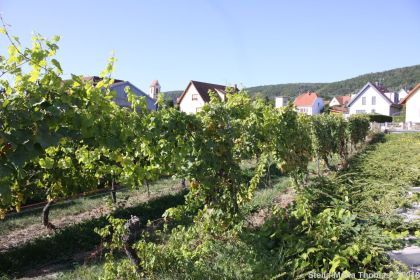
We’d begun with a delicious breakfast (including a glass of crémant) at the Hostellerie le Marechal, and then checked the car to see if anything had fallen off after our encounter with the ironwork the day before (nothing seemed to have done, but there was a rattle that suggested the exhaust system might have been compromised) so we undertook the 15 minute drive to Voegtlinshoffen and the cellar visit organised by the hotel for us.
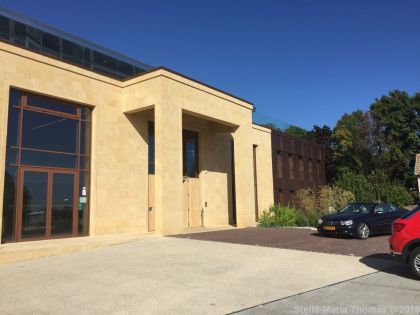
We were going to see a specialist in the crémant on offer at breakfast, Joseph Cattin, where the family have been making wine since 1720. It all started with François Cattin, who was Swiss, and who settled in the village where he was also a builder. They are 11 generations in now and still going strong as one of the largest family owned vineyards in Alsace.

In 1850 they shifted to wine making exclusively, with Joseph taking over the family-owned Estate just as phylloxera hit at the end of the 19th century. Joseph dedicated his time to finding was to fight this plague, becoming a pioneer of Alsacien viticulture. Meanwhile his brother headed off to Paris and set up a restaurant called La Cigogne (the Stork) which served Alsacien gastronomy to well heeled Parisians and foreign guests, acting as a shop front for the wines his brother was making.

Almost a century later the 10th generation modernised the estate and started worldwide exports of their products. It’s now being run by Jacques Cattin Junior, who has been in charge of winemaking since 2007, and his wife Anaïs, who runs the international sales department. What they now have is a fantastic range of wines, and a modern winery that includes a rooftop bar where you can try the wines alongside plates of charcuterie and cheeses. We were taken round by the charming Marianne, who showed us around the original winery, where we could see both the old wooden barrels and the hyper-modern temperature controlled stainless steel tanks.
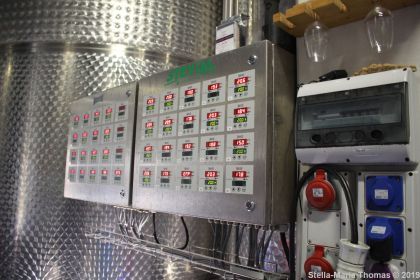
They even have pipes running under the road to enables the grapes to be crushed on one side of the road in what looks like the original building, and then run straight into the stainless steel tanks in the building on the other side of the road! It’s a most impressive set-up and the wines they produce reflect that.
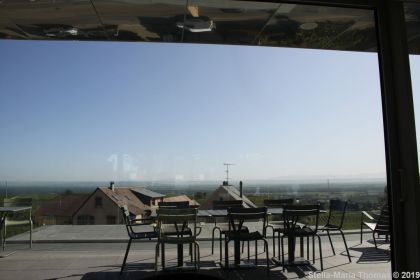
After our visit, and an explanation of many of the processes, we sat down with Marianne to try a number of wines. Even using the spittoon, after we got through it seemed like a good idea to get something to eat, and where better than the rooftop bar, the Belvedere, with its phenomenal views over the surrounding landscape. It would also give us the opportunity to discuss which of the wines we’d tried we actually wanted to buy.
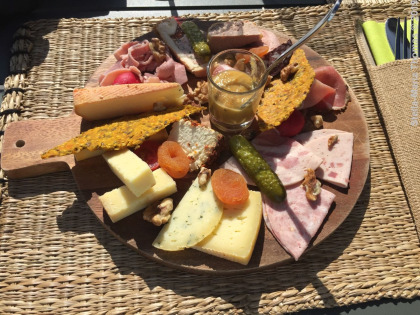
A plate of charcuterie and cheese later (and a free glass of wine with lunch) and we were ready to shop. 6 boxes of wine later we were helped to load the car (after a swift unload to make sure everything went in in the right order) and presented with a bottle of wine that Marianne said was her favourite crémant to add to the haul we’d paid for. We were liking this free wine thing! We were ready to pick our way carefully back to Colmar for the rest of the day.
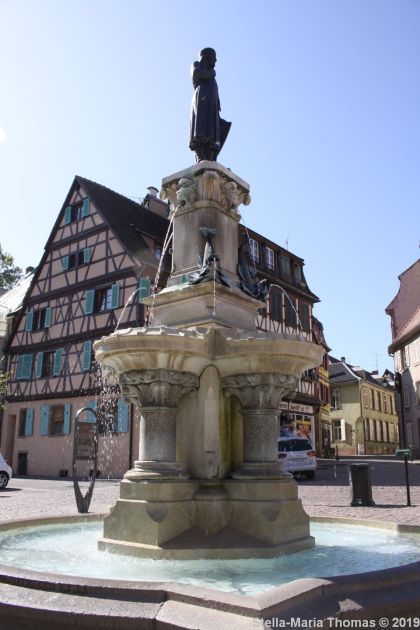
Having dropped the car back in the car park, we headed into town to hunt down the Tourist Information office to see what information we could pick up. We kept on getting sidetracked though because Colmar is jaw-droppingly lovely and there were oddities round every corner, like the giant soft toy gingerbread man! At least we understood that gingerbread is very much an Alsace thing. There are those who claim that the crusaders brought it back to Europe, but how true that is I have no idea. Also that the Chinese started it, with Mi-Kong (“honey bread), a delicacy made from wheat flour and honey, fragranced with aromatic plants and baked in the oven. Whatever the case, Alsaciens like it, and it’s everywhere, even made into liquers and spirits that can be added to crémant to make a kir!
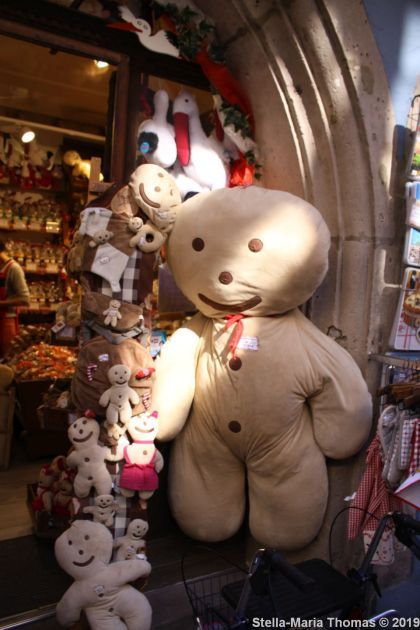
There was an artisans’ market going on in the former Customs House (the Koifhus) which detained us for a while, both looking at what was on offer and getting a look inside the building. It was planned in 1433, and the current building dates to 1480 and two more buildings were added in the 16th century. The condition of the building in the 19th century was so poor that it came close to being demoloshed, but instead it was restored in the late 1890s, when a turret and glazed tiles were added. It was renovated again in 2002 to replace the Renaissance style sandstone balustrade which was removed in 1976. It was used as a warehouse and as a place of taxation for imported and exported goods as well as for meetings of the representatives of the Décapole, the federation of the 10 imperial cities of Alsace. Today it was being used to display a range of attractive good including some glassware that really caught my eye.
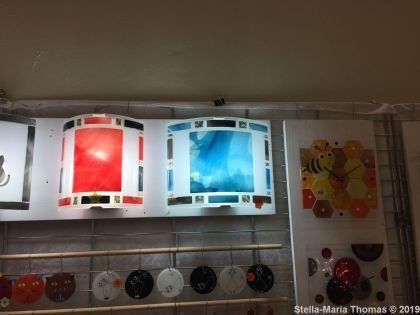
We stopped off to look at the collegiate church of Saint Martin. It dominates the square on which it sits and is as impressive inside as outside. The building itself was constructed between 1235 and 1365 and is a brilliant example of Gothic architecture in Alsace. Needless to say with a city as closely packed as Colmar is, there have been frequent fires, and in 1572 the framework of the south tower and all the roofs were destroyed, so what you can see now is much more modern. It has also undergone several restorations, the most recent in 1982 which gave the archaeologists a chance to have root around. They found foundations of a 1000 year old church as well as traces of extensions from the 11th and 12th centuries.
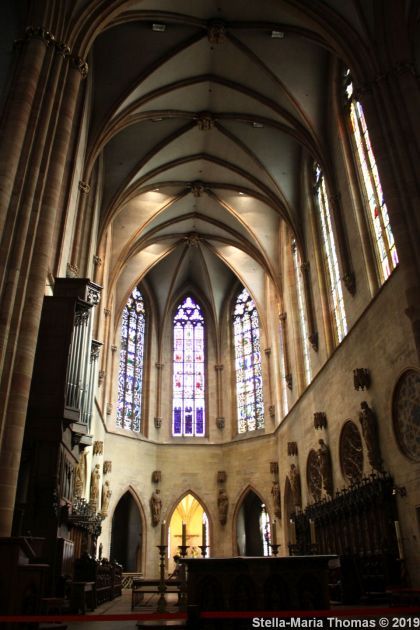
It’s an interesting church and there are a number of features that are quite surprising to the modern visitor, including the anti-semitic and downright offensive so-called “Judensäue, a testament to the troubled history of the Jews in Alsace, that came to a ghastly climax in 1349, when they were accused of causing plague by poisoning the wells. On February 14 several hundred Jews were massacred during the Strasbourg pogrom and any remaining Jews were forbidden to settle in the town, being reminded every evening at 10 o’clock by a bell and a municipal herald blowing the “Grüselhorn” that they had to leave. I’m guessing the only reason they stayed in the surrounding towns was the lack of anywhere else they could go, if the prevailing attitude was so vile.
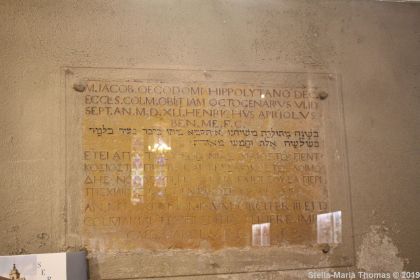
The interior is quite plain, having lost a lot of its furniture during the French Revolution, but it does still have one of the many Baroque organs built by Johann Andreas Silbermann that are everywhere in the region. There are also a nubmer of medieval altars and statues, and a rare Gothic stained glass window of a beardless Christ. The Isenmann altarpiece, of which more in another post, was originally here as well. In 1462 the municipal painter Caspar Isenmann was commissioned to paint a set of panels dedicated to the life of Christ and he completed the word in three years. In 1720 the altar was removed and the paintings were dispersed. The seven surviving panels have been in the Unterlinden Museum since 1853.

We eventually made it to the Tourist Information Office were we realised that for what we wanted to do, the Colmar City Card was actually a good deal. It was €32 each for seven days and gave you access to all the museums (six of them, and you could visit as often as you wanted) as well a trip on one of the tourist trains and a boat trip. We went for it, and then decided we’d have a gentle ride round town on the tourist train straight away. I know some people think they’re a waste of effort but I find them a useful way of getting my bearings, as well as a good excuse to have a sit down…
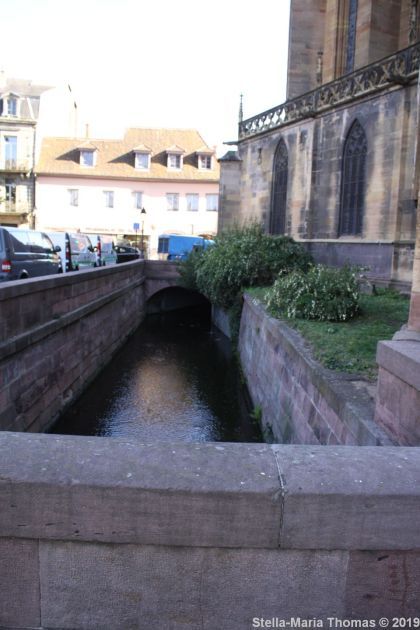
Afterwards we decided that we had time for one of the museums. We opted for the Musée Bartholdi.
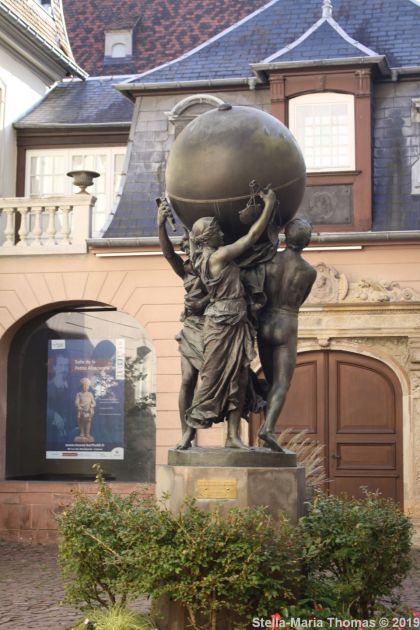
It’s a museum dedicated to the French sculptor Auguste Bartholdi, the man who designed the Statue of Liberty, among other colossal works. The house was his birthplace and is full of works by him. These include a lot of preparatory models for monuments that are actually in Colmar, many of which we would find during our stay. I hadn’t realised he also put forward a design for the fountain on the Quinconces in Bordeaux, and the museum had a model for one of the horses to prove it. What’s there is insane enough. Lord knows what he would have built given half a chance.
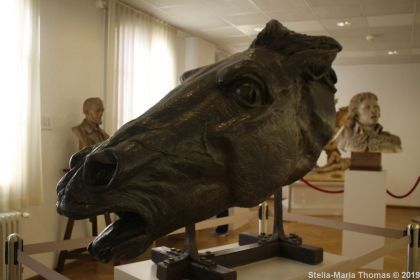
Bartholdi served in the Franco-Prussian War of 1870 as a squadron leader of the National Guard, and possibly as a liaison officer to Italian General Giuseppe Garibaldi. As an officer, he took part in the defense of Colmar from Germany, and after the Alsace’s defeat he constructed a number of monuments celebrating French heroism in the defence against Germany. One of those projects was the Lion of Belfort, which is huge. He didn’t do anything by halves, it seems.
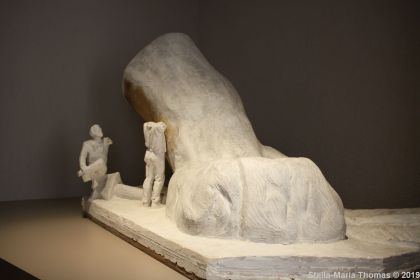
Then in 1871 he he went to the United States where he suggested the idea of a massive statue to be given by the French to the Americans in honor of the centennial of American independence. The result was “Liberty, Illuminating the World” as she’s more correctly known. There were lots of items telling the story of the design and construction, though sadly most of it is in French with no translation into any other languages. This seemed a bit of a shame, really, as it was fine for people like me, but I’m pretty sure a lot of visitors won’t be able to read French and could probably do with some help to understand exactly what was going on.

We stepped back out later having learned something new, which is never a bad thing. It was time though to quit for the day and go back to the hotel for dinner. The area round the hotel was looking especially lovely so we decided we’d step out from the hotel to look for an aperitif later on.
Travel 2019 – Alsace and Baden, Day 7, Voegtlinshoffen, Colmar Thursday, 19th September 2019 - Voegtlinshoffen, Colmar Voegtlinshoffen is a tiny village which is not one of the half-timbered confections that so many Alsace villages are, because most of those were destroyed in the course of the Thirty Years’ War and rebuilt afterwards in a more simple style.
#2019#Bars#Churches#Collegiate Church of Saint Martin#Colmar#Cooking#Drink#Europe#Food#Food and Drink#France#History#Hospitality#Hostellerie Le Maréchal#Hotels#Joseph Cattin#Musee Bartholdi#Museums#Restaurants#Travel#Voegtlinshoffen#Wine
6 notes
·
View notes
Text
Wednesday, 17th September 2019 – Illkirchen, Château du Haut-Kœnigsbourg, Colmar
Wednesday morning, with even more insect bites decorating both of us, we got ready to check out and move on. I’d been for a run before breakfast and stopped off at the rather odd park near one of the tram stops. For reasons I couldn’t begin to fathom, the park contained a number of “Easter Island” heads. No. I have no idea. Apparently Place Malraux contains an Armenian Oak, which counts as a remarkable tree, but there’s no connection there that I can find. And the really weird thing was that they wouldn’t be the only Easter Island head style sculptures we would encounter, we would find more on the penultimate day of our holiday.
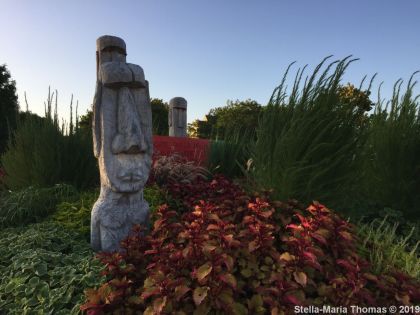
Anyway, they amused me. By 10:30 we’d got the car packed and were ready to go. Our landlady turned up on time, despite us not having done so on check-in and we were soon on our way to Robert Blanck to buy the wines we’d decided on. That was easily achieved, and the lovely lady serving us insisted on slipping a few extra goodies in (a couple of “top hat” Champagne bottle stoppers), especially after we bought a creme de peche as well (made from vineyard peaches) and we wended our way onwards to Famille Hauller, but could find no one around, despite Ludovic having suggested he would be there between 11 and 12. We decided to save Domain Sylvie Spielmann for later in the afternoon and thus headed for Chateau Haut-Koenigsbourg. We’d heard more about it on our wine tour, when Olivier asked if anyone on the tour was a “Lord of the Rings” fan, because if so we needed to visit the castle. Apparently “some guy” had used it as inspiration for some of the set design. Given our proximity to Switzerland, Lynne and I put two and two together and figured he was probably talking about John Howe, the Canadian artist who lives in Switzerland and who was one of the two artists deeply involved in the look of Peter Jackson’s films. A minimal amount of research later and I’d confirmed this was indeed the case, and that there’d even been an exhibition there last year. We had to go. There was no choice, not when the information I’d found said: “Several decades later, John Howe, the famous illustrator of Heroic Fantasy publications, fell in love with the château’s mysterious atmosphere on his first visit here during the 1980s. He used it as the inspiration for the design of the Citadel of Minas Tirith after he was appointed to the post of Conceptual Designer for Peter Jackson’s ‘The Lord of the Rings’ trilogy”. Just for good measure it also appears in its real form in Jean Renoir’s 1930s masterpiece, “La Grande Illusion”, and the considerably less famous “Les aventures d’Arsène Lupin” in 1956, but to keep the masterpiece theme going, it can also been seen in the animated classic “Howl’s Moving Castle”. 3 out of 4 then!
We drove up a winding and slightly white-knuckled road and eventually found ourselves on the loop in the road that leads up to the castle and then back down again. It was very, very busy and we decided that we’d try and get a good parking space rather than having to flog up the hill on what was another hot day. As we passed the apex and started to drop back down again we found a space that was actually big enough for my car (and it’s not a big car). And then we looked up! The castle is a monster of a structure, and looks just like you think a medieval castle should, looming massively against the skyline.

Its history, however, is slightly different to what you might expect, as with so many things in this part of the world. There’s mention of the Buntsandstein rock as Stophanberch (Staufenberg) in a 774 deed issued by Charlemagne, and it crops up again in 854, by which time it belonged to the Basilica of St Denis and may have been the site of a monastery. It all goes quiet again until 1147, when there is a record of a castle built by the Duke Frederick II of Swabia, one of the Hohenstaufens and called Castrum Estuphin, something the monks were not happy about as the record is a complaint to King Louis VII of France about it. The offending builder’s younger brother Conrad was elected King of the Romans in 1138, and was succeeded by his nephew, Frederick’s son, Frederick Barbarossa in 1152 and it wasn’t long before the name of this commanding fortress changed to Koenigsburg (king’s castle) or Kinzburg.

Eventually it passed to the Dukes of Lorraine, who entrusted it to the local Rathsamhausen knightly family and the Lords of Hohenstein, but the behaviour of a gang of robber barons who used the castle as a hideout so enraged the neighbours that it was occupied by the Elector Palatine in 1454, and less than a decade later it was set ablaze by the unified forces of the cities of Colmar, Strasbourg, and Basel. The Habsburgs handed the ruins over to the Tiersteins who rebuilt and enlarged the castle, supposedly in a way that meant it would be able to withstand modern artillery fire. No one told the Swedish artillery forces who broke through and overran the castle during the Thirty Years War and it was finally burnt to the ground in 1633 and left to fall into ruin for a couple of centuries. You wouldn’t know it though.
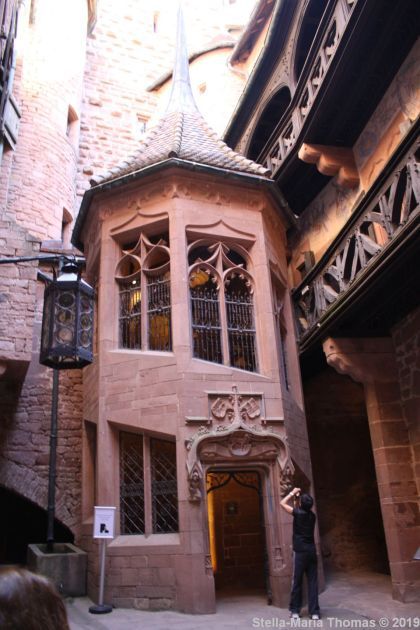
It was classified as an historical monument in 1862, and in 1865 it was bought by the town of Sélestat. There were plans to restore the place, but there were no funds to complete the work. Alsace was in one of its phases of being part of Germany, so the ruins of the castle were offered to Kaiser Wilhelm II in 1899. Having abandoned his plan to restore Schloss Rheinfels, he must have pretty much snapped their hands off. What followed was a remarkable 8-year long building project, where money was no object, and the most modern techniques were used. The castle would be completely restored, with the emphasis on as much historical accuracy as possible. To that end, a young architect, Bodo Ebhardt was put in charge. It helped that he was also an architectural historian, a castle explorer, and the founder and longtime president of the German Castles Association (Deutsche Burgenvereinigung). He was very thorough and after he had analysed the remaining ruins and façades, he read up as much as he could in old documents and records, and looked at other castles to draw comparisons.
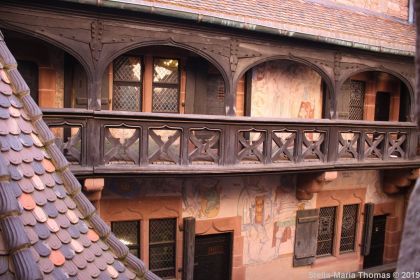
He even made sure that those who came after would be able to easily identify the new parts of the walls, creating a new set of ‘mason’s marks’ to be used on any replacement stones, and gave different marks to different years. You can still see the marks if you know what to look for. It’s a fabulous place with some startling detail and although much of it is not authentic, you can completely forget that as you go round.
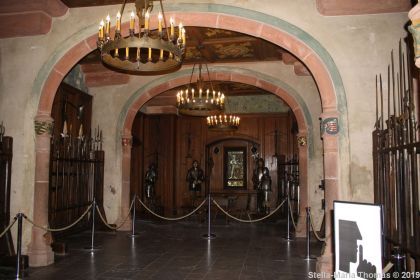
After an 8-year build, on May 13th 1908 the château was unveiled to the public with a parade and pageant involving five hundred performers in period dress. Of course after World War I it reverted back to being French, and became a tourist attraction, though apparently the French visitors would regularly criticise the restoration work because it had been carried out by the enemy. Surviving both World Wars undamaged the building was classified as a Monument historique (listed building) in 1993 and is now owned by the Conseil Départemental du Bas-Rhin.
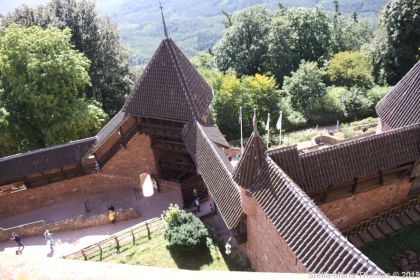
As we wandered around, the views were staggering. You could see just why anyone with an ounce of strategic sense would want to build a fortress on just this spot. No one is going to be able to sneak up on you, that’s for sure.
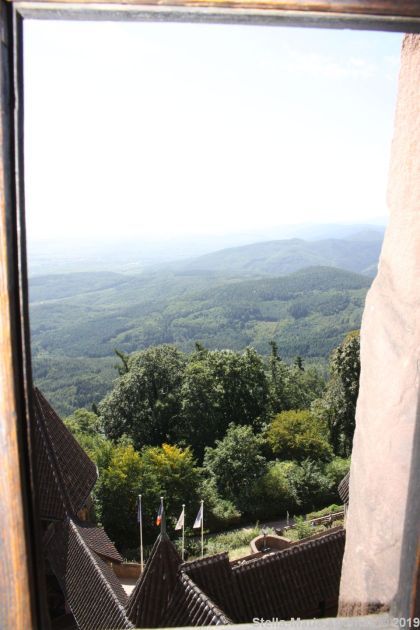
After a couple of hours poking into all the nooks and crannies, we reckoned we needed a refreshment stop. The Library restaurant offered all sorts of options including some and cake. We were booked for dinner at our hotel that night and really didn’t need any more than a light snack. As there weren’t any of those on offer (Alsacian cuisine really does lean towards German sized portions, or at least ravenous vineyard worker sized portions alongside French refinement) I had a slice of mirabelle cake, and a bottle of cold water.
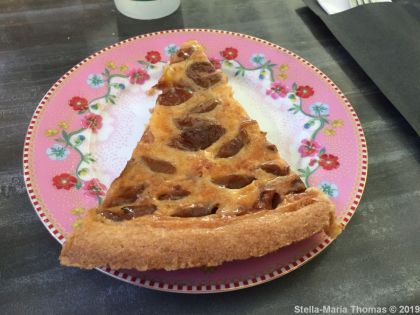
We had a look around the medieval garden that had been set up outside, but it had somewhat gone over due to the extremely hot weather and a general lack of care. Afterwards, we sauntered back to the car and headed over to Sylvie Spielmann, where we made a massive dent in our wine buying budget. We also made a massive dent in the bottom of my car when we collected a piece of ironwork that was sticking up out of the sandy base level that a road under reconstruction had been reduced to. It got stuck, dragged along for several feet, and I was only able to get off it by reversing and then rocking forward a couple of time. I’ve yet to figure out what damage has been done precisely, but it is going to need looking at.
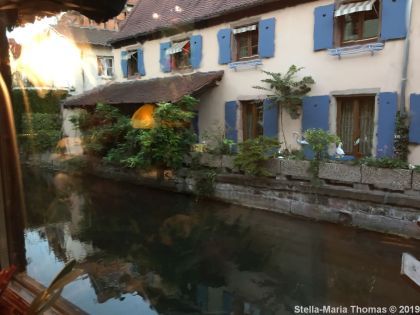
From there we reloaded the car again, shuffling everything round as best we could to keep the next night’s bags at the top of the luggage pile, and headed to Colmar and the our hotel for the next three nights, the Hostellerie Le Maréchal. We arrived in good time, and unloaded. I then had to drive the car to the nearby underground car park, because a hotel built in 1595 isn’t going to have built in car parking! It was a hot walk back and I annoyed myself by leaving my handbag in the car and having to walk back again almost immediately. Once in though, we were able to get ourselves organised and cleaned up and then investigate the possibility of an aperitif in the hotel bar prior to dinner in their restaurant a l’Echevin.

We had a lovely view from our window of the canal and some of the typical local barques which were the only vessels shallow enough to navigate from the market garden areas to the market hall back in the day, and which now carry tourists up and down.

Colmar looked lovely, the hotel was glorious, we had one of the suites with a “Little Venice” view, and we looked to be in for a lovely stay. As we had dinner at the hotel twice, I shall write about that elsewhere.
Travel 2019 – Alsace and Baden, Day 6, Illkirchen, Orschwiller, Colmar Wednesday, 17th September 2019 - Illkirchen, Château du Haut-Kœnigsbourg, Colmar Wednesday morning, with even more insect bites decorating both of us, we got ready to check out and move on.
#2019#A l’Echevin#Arts#Cafés#Castles#Château du Haut-Kœnigsbourg#Colmar#Domaine Sylvie Spielmann#Drink#Europe#Famille Hauler#Films#Food#Food and Drink#France#History#Hospitality#Hostellerie Le Maréchal#Hotels#Illkirch-Graffenstaden#John Howe#Parks#Robert Blanck#Travel#Wine
5 notes
·
View notes
Text
Friday, 20th September 2019 – La Maison Rouge, Colmar
This is now a slightly cautionary tale. Because the guy on the front desk at the hotel when we checked in insisted that we had dinner included for all three nights, despite me saying we didn’t, I believed him in the end, and cancelled a reservation at l’Atelier de Peintre which I’d been looking forward to. When it turned out I was right, it was too late to get a table there or anywhere else I was particularly keen on. After checking Gault-Millau I finally wound up getting a table at La Maison Rouge which was rather more prosaic than some of the restaurants we’d hit so far. Still, it wasn’t all bad, just not what I’d been hoping for. But more of that later.
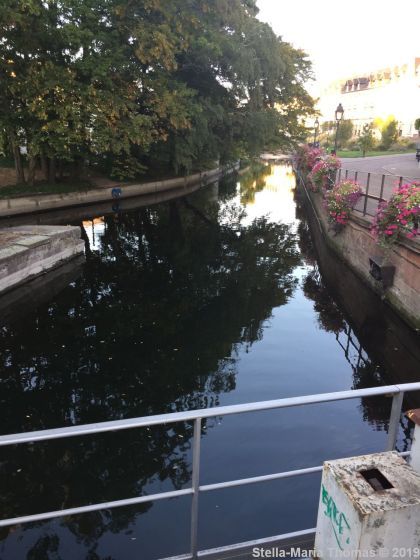
We took a short walk before dinner, stopping for a glass of wine at a small bar that had tables out on the pavement. At dusk Colmar was particularly lovely, as well as a lot less crowded with tourists taking selfies. It may be just me, but I don’t understand the selfie thing. Your friends all know what you look like; they don’t necessarily know what the place you are visiting looks like… but what they get is a photo of you, your face distorted by the lens, and a blurry background that might not even be real. Here’s a photo of Colmar without my face…

We reached the restaurant in good time, and were soon seated with a glass of rosé crémant and a small bowl of tiny bretzels. I felt the room was overly bright, but otherwise it was a welcoming space, and the staff were friendly and helpful.

After a study of the menu we opted for sharing our starters, with an order of duck and goose foie gras terrine…
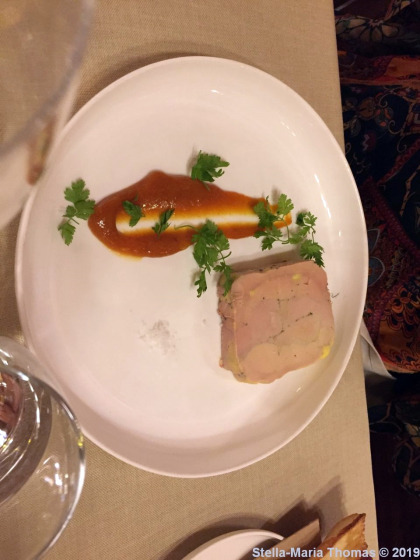
And another of carpaccio of red Carabinéros prawns. These were both very good, the terrine being just what you’d expect given the components, and the prawns being tender and delicate, with just the right sea-salt hit.

The sommelier was needed to assist us because the wine list was more of a bible and picking the right option was not going to be easy, at least not during the course of a single meal. We ended up starting with a 2010 Grand Cru Brand Riesling from the Cave de Turckheim. It’s produced from grapes grown on a granite slope overlooking the medieval town of Turckheim and enjoys an amazing amount of sunshine. According to legend, it was here that a battle took place between a dragon and the sun though what effect that has on the wine is anyone’s guess! These wines are distinguished by their great elegance, balance and finesse, though the wine maker’s description of the 2017 vintage is a bit strange: “citrus, grapefruit and pineapple flavours. Nervous, dry, long and elegant, very well balanced”. What does “nervous” even mean in this context? It went well with the starters though.

I decided I really needed to have choucroute at some stage, so I went for it. It might not have been my smartest choice, but the locals seem to think that fish goes with sauerkraut so I ordered it. I’m not convinced. The elements separately were fine, the choucroute just right in terms of seasoning, the fish cooked nicely, but it just didn’t go together for my tastes. It was also far too big. I ate the fish separately, and then a potato or two to cleanse my palate and let me actually enjoy the cabbage.

Lynne ordered fish as well and got a beautifully cooked piece of sea bream in a lovely, delicate sauce, with a separate puree of celeriac. I really should have done the same.
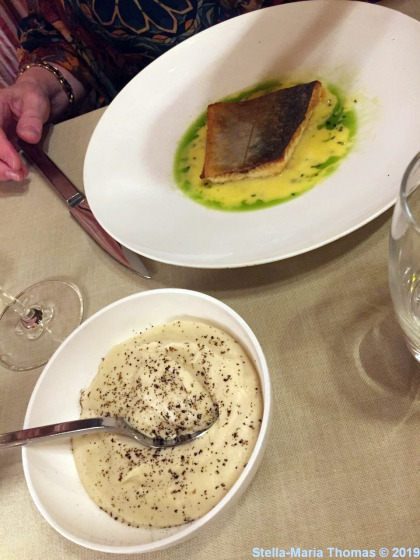
We drank a 2017 Gewurztraminer from Domain Albert Mann from Wettolsheim and Kientzheim, grown on marly-limestone. It’s a lovely light yellow colour with golden highlights. The bouquet is powerful and complex, an explosion of exotic fruits, flowers and spices and it really worked. We were much impressed with the sommelier and his recommendations. We finished the wine in place of dessert as neither of us could eat another thing. It was that German-sized portions thing again…
We took a slow walk back to the hotel along the Lauch, stopping to enjoy the reflections in the water.
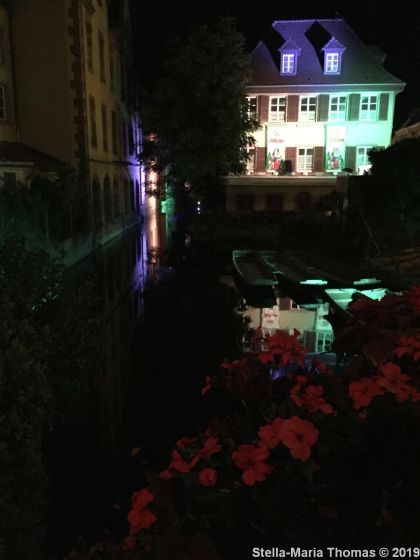
It hadn’t been a bad dinner, and in fact it was way better than it could have been. On arriving back at the hotel we ordered a final glass of wine, a 2015 Gewurztraminer Vendanges Tardives from Pierre Henri Ginglinger, and retired to bed. Tomorrow we would be moving on to Mulhouse, stopping off in one or two of the wine route towns on the way.
Travel/Food 2019 – Alsace and Baden, Day 8, La Maison Rouge, Colmar Friday, 20th September 2019 – La Maison Rouge, Colmar This is now a slightly cautionary tale. Because the guy on the front desk at the hotel when we checked in insisted that we had dinner included for all three nights, despite me saying we didn't, I believed him in the end, and cancelled a reservation at…
#2019#Colmar#Cooking#Drink#Europe#Food#Food and Drink#France#Hospitality#Hostellerie Le Maréchal#Hotels#La Maison Rouge#Mulhouse#Restaurants#Travel#Wine
0 notes